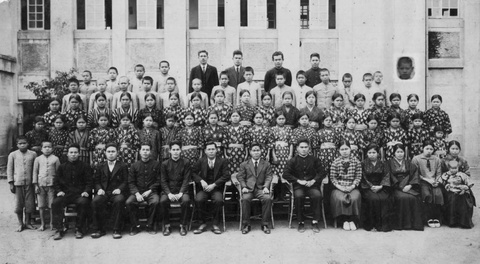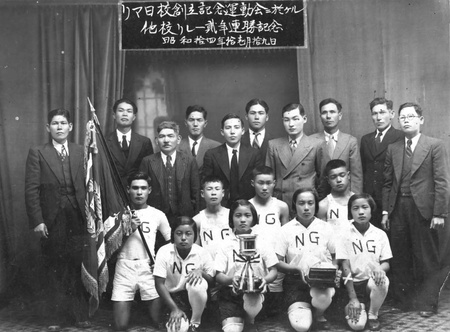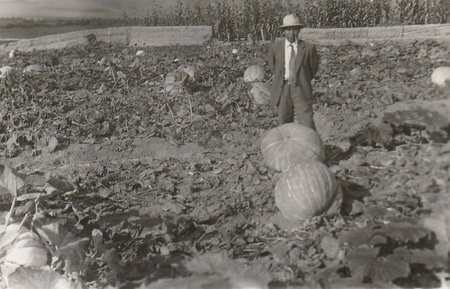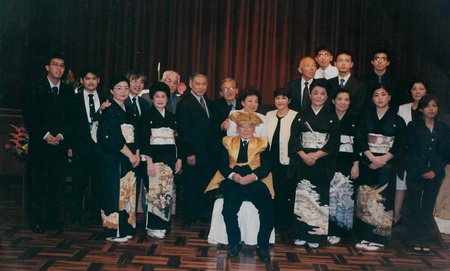Ginyu Igei arrived in Peru with the halo of sensei. A teacher in his native Okinawa, the 26-year-old was assigned to the Japanese school in Chancay (a district located north of the city of Lima), where he would be deputy director. It was 1934 and the oldest of six brothers left Kin, his town, with a promise to his father to return.
He arrived in Peru with his wife, also a teacher. They had three children and after passing through Chancay they settled in Lima, where Ginyu served as director of Nanko Gakuen. Everything seemed perfectly on track, but fate twice got in the way of the Igei family.
The first blow was the death of Ginyu's wife due to illness. The sensei was left a widower with three children, the youngest of them almost newborn.
The second was the Second World War, which definitively ruined Ginyu's intention to return to Okinawa to fulfill the commitment that—as a Chonan —he had established with his father.
The war prevented me from seeing him again.
SAVED IN EXTREMIS
Ginyu Igei could have emigrated to Hawaii, but the story of a countryman who had settled in Peru and temporarily returned to Okinawa, where he shared his rich experiences in Peruvian lands, as well as the opportunity to co-direct a Japanese school, tipped the balance towards South America. .
In addition to teaching, Ginyu materialized in Peru a desire that he carried from Japan: to be a farmer. The Okinawan divided his time between raising children and producing food.
The one who tells the story of this atypical Issei is his fourth son, Jorge, who owes his existence to the providential intervention of the owner of the farm where his father grew bananas during World War II.
Ginyu was included in the so-called black list that contained the names of Japanese immigrants that Peru, on behalf of the US government, had to detain and deport to the United States.
The police grabbed the sensei, whose future seemed set in stone (an American internment camp). He was saved by mentioning the landowner he worked for, a man named Lavalle.
To make sure he was telling the truth, the police called Lavalle, who turned out to be a high-ranking official in the Peruvian government.
The man confirmed the information provided by the Okinawan and also praised his ability as a farmer.
The police released Ginyu, who was able to continue with his life in Peru.
The fact that Japanese education was prohibited by the Peruvian authorities during the war did not deter the sensei, who together with other Japanese teachers formed clandestine schools, in private homes, to teach nihongo to Nisei children.
In addition to imparting knowledge, with the money he earned as a farmer he published mimeographed books in Japanese (educational material) and helped insolvent Issei finance their children's education so that they could continue studying.
How could Ginyu be a teacher and a farmer, and at the same time a widowed father of three children? When he was busy with his work, his eldest son took care of the two younger ones or those close to the sensei—friends, neighbors—watched over the boys.
The situation improved during the postwar period, when the Igei family grew—in number of members, in love—with the arrival of Ginyu's second wife, a Hawaiian Nisei of Okinawan ancestors.
The professor's fourth child was born from the marriage. A link that would not have been possible if Ginyu had been deported to the United States. Without the validation of the landowner Lavalle, “I would not have been born,” says Jorge, director of the Museum of Japanese Immigration to Peru.
The arrival of his mother was also important for his orphaned siblings. “They were warm from their mother,” says Miriam, Jorge's wife, who remembers her mother-in-law as a happy woman who “laughed at everything.”
Incidentally, in her native Hawaii she witnessed an event that changed the history of humanity. On December 7, 1941, he saw Japanese planes flying over the island and shortly afterward he heard bombing.
GINYU WAS NOT CRAZY
“More than a teacher I wanted to be a farmer. His idea was to emigrate to be a farmer,” says Jorge about his father. And it was food production that he dedicated himself to full time during the post-war period.
Ginyu did not cultivate solely guided by experience or instinct. He studied, he researched, he had contacts in Japan to improve his techniques or have them send him supplies.
He produced one hundred kilo pumpkins, seedless watermelons, and defying the doomsayers (“Hey, Igei, are you crazy? You're not going to plant potatoes here, this is not a potato area. You're going to go bankrupt,” a neighbor warned him), he produced large quantities of potatoes in virgin land for the tuber.
In the 1960s, in order not to lose the lands they owned amid anti-foreign government policies, Ginyu and his wife became nationalized: he went from being Japanese to Peruvian; her, from American to Peruvian.
When the field became too small for him, Ginyu added a milestone to his career as a versatile man: he ventured into commerce through a winery, a restaurant and the sale of pianos (an instrument that he also played).
In addition, he acted as a cultural promoter in 1969, when he took the film Living in Hawaii to Peru, Brazil, Argentina and Bolivia, which documented Japanese immigration to the North American state.
In parallel, he developed a prominent career as a leader in the Nikkei community, which led him to the presidency of the Okinawan Fraternal Association (today the Okinawan Association of Peru) and the Central Japanese Society (today the Peruvian Japanese Association).
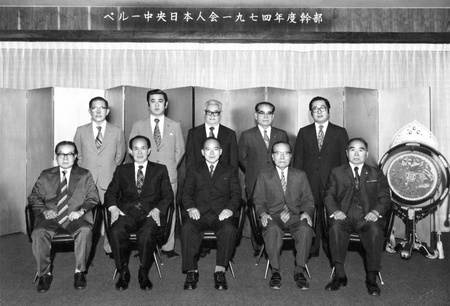
His fruitful work earned him multiple recognitions (including a decoration from the Japanese government) that fill the walls of Jorge's house, which seems like a shrine dedicated to his father.
SPEAKER, MEMORIOUS, CHARISMATIC, DANCER
What was the person behind the character like? “With his family he was quite sparing, perhaps because of the language,” says Jorge, who remembers his father as a loquacious conversationalist with people who spoke Japanese.
Miriam evokes her father-in-law as an excellent orator. “I could say long speeches from memory. “I remembered everything, everything: the history, the data, the names,” he says. “But with the family he was a little more reserved because of the language,” she explains in line with what her husband said.
“He had quite a bit of charisma. Sometimes there were Western ladies who looked at him holding his hand, they were very fond of him. “It aroused tenderness,” says Jorge.
Physically small, his oratory skills made him bigger. At family or social gatherings, he used to deliver the speeches. “He spoke to you very strongly,” his son recalls.
Miriam also describes him as a very simple man, who worked equally well on the plains as he moved in lofty environments.
“I saw my father-in-law washing dishes. 'And why are you washing the dishes?' 'The lady who helps is sick.' 'But there is another person.' 'No, no, I'm going to help.' Another day you found him doing something in the store. 'Why is he doing this thing?' 'I just have to help.' And from there I had a meal at the (Japanese) embassy. He could be doing such an everyday thing, getting dirty and everything, and suddenly he would get really nice, with his little tie, and go to an event.”
Ginyu was very strict about community ties and social responsibilities.
He never failed with the envelopes for the mourners at the wakes. He complied with everyone. As soon as he found out that someone in the community had died, he told Jorge “we have to go,” even if it was late. If they told him to go the next day, he would reply: “If I found out today, I have to go today.”
Now, Ginyu could be of monastic rigor to honor moral commitments, but also a festive soul. Jorge remembers him closing the party of his 97th birthday dancing and dancing, a display of vitality that contradicted his ID.
AN OPEN-MINDED UCHINANCHU
Being a sensei—in a community where the Issei had not had the opportunity to pursue higher education—carried with it a status that distinguished him. Jorge remembers that other immigrants called his father to write letters to Japan.
Although he abandoned teaching in middle age, Ginyu never lost his voracity for reading and constantly kept up to date.
Jorge keeps books in his house that belonged to his father, including a copy of Les Miserables in Japanese published about a century ago.
The sensei was a rare bird in Japan in the 1930s, an internationalist in a militarized and fiercely nationalist country. He encouraged young people to migrate abroad to see the world (this way they also avoided being recruited by the army) and Jorge believes that “having read many Western authors must have opened his mind.”
In those years, Hawaii was a dream destination for young Okinawans. Many Uchinanchu had migrated to the archipelago and made money, with which they returned to Okinawa as prosperous entrepreneurs, filling the eyes of the locals.
Ginyu taught classes to young people to provide them with basic information about America so that they would not migrate blindly.
Although Ginyu stood out for Okinawa, he did so “without separatist sentiment,” Miriam clarifies. “He was not a chauvinist, he was a conciliator,” Jorge complements. This spirit of harmony made it possible for him to get along well with the Naichijin at a time when there was a strong rivalry in Peru between the Uchinanchu and those born on the “big island.”
Jorge realized his father's historical stature in the community thanks to the deference that others gave him. “It caught my attention that his students treated him with a lot of respect, many strange people called him 'Igei sensei', he bowed his head,” he remembers.
Ginyu died in 2005, aged 97.
That a play about his life has been premiered in Okinawa and that the Japanese language classrooms at the Peruvian Japanese Cultural Center bear his name show how alive the character is.
“I considered him to be an important person, but perhaps not to the magnitude that I later discovered,” says Jorge.
Miriam remembers that in the last years of Ginyu's life they became more aware of his significance. When they organized their birthdays, there were so many people who wanted to attend that they had to build a dam to contain the human tide.
“Everyone wanted to go, everyone had a story to tell about him, whether it was because he helped him when he was young, whether it was because he taught him, different things,” he says.
For this reason, both have transmitted to their children that “it is a pride to be Igei.” The light of the teacher is a beacon without expiration.
© 2023 Enrique Higa Sakuda


